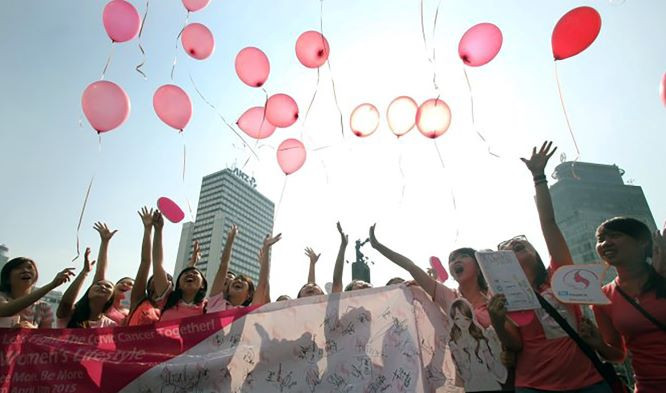HPV vaccine rollout: New hope in fight against cervical cancer
The government's plan to roll out the HPV vaccine as part of the national childhood innoculation program is a big step toward a world free of preventable cancers.
Change text size
Gift Premium Articles
to Anyone

G
ood news for Indonesian women and girls: Health Minister Budi Gunadi Sadikin recently announced that the government would incorporate the human papillomavirus (HPV) vaccine into the school-based national immunization program (BIAS), with 5 million covered annually under the scheme. Without this, a woman would have to spend between Rp 1 million (US$69) and Rp 4 million for the complete HPV vaccine regimen.
The HPV vaccine is a game-changer in the war against cervical cancer, the second leading cause of death in women globally. Nevertheless, concerns regarding the program loom among the general public.
More than 95 percent of cervical cancer is caused by persistent HPV infection. The virus transmits mainly through sexual contact and infects both women and men. Besides cervical cancer, it also manifests as anogenital warts, anogenital cancers and oral cancer.
Although widely known as a “cancer vaccine”, the HPV vaccine does not directly prevent cervical cancer but rather, the predisposing HPV infection. It contains inactive particles of the viral antigen of high-risk strains (16 and 18) that account for 70 percent of all cervical cancer cases.
There are two types of vaccine available in Indonesia: the bivalent Cervarix, which covers types 16 and 18, and the quadrivalent Gardasil, which includes two additional strains that cause warts (6 and 11). A complete regimen requires two doses for adolescents aged 9-14 and three doses for those aged 15 and older.
The vaccine has robust evidence of efficacy. It offers a significant protection of 88-95 percent against infection and 92-100 percent against disease. The United Kingdom initiated a national HPV vaccination scheme in 2008 and found that vaccinated girls aged 12-13 had 87 percent less cervical cancer than their unvaccinated cohorts.
No major safety concerns have been raised. Pain in the injection area due to the amount of aluminum adjuvant is the most common side effect. There is no evidence the vaccine affects fertility or the menstrual cycle. In addition, the HPV vaccine’s manufacturing process does not use pork-derived gelatine and therefore, should easily be accepted by Muslims.
Although the data on its efficacy and safety are solid, some points of contention over the vaccine remain. Some question if the decision to launch the HPV program now is reasonable, especially amid the economic blow of the COVID-19 pandemic, and instead suggest using the existing screening program covered by universal health coverage.
However, screening and vaccination target fundamentally different at-risk groups. Visual inspection and the Pap smear test aim to detect evidence of chronic infection in sexually active women. In contrast, vaccination aims to prevent infection in the first place. One does not supersede the other in the national strategy to tackle cervical cancer.
In addition, HPV vaccination is very cost-effective in reducing the health burden of cervical cancer compared to screening. The program can piggyback on the existing immunization program, eliminating the risk of logistical challenges. From a healthcare provider's point of view, it is also easier and more practical to administer an injection than obtain a biological specimen for screening.
Recent data suggested a high efficacy of a single-dose regimen, which may further halve the vaccine cost. Since 2016, pilot projects have demonstrated high coverage in some areas, including Jakarta and Yogyakarta.
As the pandemic has increased awareness of vaccine-preventable diseases and improved the health system's capacity for rolling out vaccines, it is a good time to seize the momentum for program scale-up.
Another dispute surrounds the target group for HPV vaccination, which has been deemed too young to receive a vaccine for a sexually transmitted infection. In Indonesia, the program aims to vaccinate students in grades 5 and 6 of elementary school.
Studies have demonstrated that girls who were vaccinated at 12-13 years old had a far lower risk of cervical cancer than those who received it above those ages. The age bracket is also a brilliant strategy to ensure maximum coverage, as the school participation rate of girls drops 5-19 percent in secondary and tertiary education.
The vaccine is most effective if it is given before the first sexual contact. The 2017 Indonesian Demographic Health Survey showed that among sexually active unmarried women, their first sexual contact was between the ages of 15 and 18 and appeared to show a decreasing trend. However, the data is prone to social desirability bias due to the nature of the question, rendering it less valid in estimating the true value. The fact that Indonesia still struggles with child marriage and undetected child sexual abuse further strengthens the justification for selecting the target population.
Having taken the first big step, the government must ensure the quality and sustainability of the program during scale-up to ensure that no girls are left behind.
First, it should tackle several challenges identified during the pilot project, such as vaccine logistics, funding and data quality. Delayed vaccine procurement and distribution places a big strain on local health offices, contradicting the idea of the vaccine piggybacking BIAS.
Moreover, the government should secure a sufficient budget for the program, including the cost of disseminating promotional materials. There is also a call to develop a standardized monitoring tool to identify and act promptly on any problems during rollout.
Second, the government must ascertain equitable access for the most vulnerable targets. As the vaccine is deployed through schools, a safety net must be made to cover those not enrolled in school or those who miss vaccination day. As the vaccine is in the form of a single injection, making it available at a local primary healthcare facility for catch-up vaccination is a feasible option.
The national policy should also provide clear recommendations for girls and women not covered by the current program, such as immunocompromised individuals who need a third dose and people who have completed elementary school.
Lastly, the program must acknowledge patients’ autonomy. Although challenging to obtain, informed assent from patients and consent from their caregivers are salient. Therefore, providing accurate facts about the vaccine and addressing hesitancy is crucial, especially with the widespread misinformation from social media.
The material must delineate the benefits and address common misperceptions. Age-appropriate and culturally sensitive reproductive health information may be included, so that caregivers can be more confident in discussing it with their children. In this case, the government may also benefit through endorsement from public figures, health workers, religious organizations and schools.
To sum up, the HPV vaccine is a safe, effective and much needed silver bullet in our fight against cervical cancer. I look forward to a life where cervical cancer caused by HPV is history, when no families lose their dearest female figures to vaccine-preventable cancer.
***
The writer is a physician pursuing a Master of Science in pediatrics and child health at the University College London Great Ormond Street Institute of Child Health under the Indonesian government’s Education Endowment Fund (LPDP).









